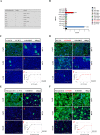Adaptive Mutation in the Main Protease Cleavage Site of Feline Coronavirus Renders the Virus More Resistant to Main Protease Inhibitors
- PMID: 36000844
- PMCID: PMC9472640
- DOI: 10.1128/jvi.00907-22
Adaptive Mutation in the Main Protease Cleavage Site of Feline Coronavirus Renders the Virus More Resistant to Main Protease Inhibitors
Abstract
The rapid global emergence of severe acute respiratory syndrome coronavirus 2 (SARS-CoV-2) has caused serious health problems, highlighting the urgent need for antiviral drugs. The viral main protease (Mpro) plays an important role in viral replication and thus remains the target of choice for the prevention or treatment of several viral diseases due to high sequence and structural conservation. Prolonged use of viral protease inhibitors can lead to the development of mutants resistant to those inhibitors and to many of the available antiviral drugs. Here, we used feline infectious peritonitis virus (FIPV) as a model to investigate its development of resistance under pressure from the Mpro inhibitor GC376. Passage of wild-type (WT) FIPV in the presence of GC376 selected for a mutation in the nsp12 region where Mpro cleaves the substrate between nsp12 and nsp13. This mutation confers up to 3-fold resistance to GC376 and nirmatrelvir, as determined by EC50 assay. In vitro biochemical and cellular experiments confirmed that FIPV adapts to the stress of GC376 by mutating the nsp12 and nsp13 hydrolysis site to facilitate cleavage by Mpro and release to mediate replication and transcription. Finally, we demonstrate that GC376 cannot treat FIP-resistant mutants that cause FIP in animals. Taken together, these results suggest that Mpro affects the replication of coronaviruses (CoVs) and the drug resistance to GC376 by regulating the amount of RdRp from a distant site. These findings provide further support for the use of an antiviral drug combination as a broad-spectrum therapy to protect against contemporary and emerging CoVs. IMPORTANCE CoVs cause serious human infections, and antiviral drugs are currently approved to treat these infections. The development of protease-targeting therapeutics for CoV infection is hindered by resistance mutations. Therefore, we should pay attention to its resistance to antiviral drugs. Here, we identified possible mutations that lead to relapse after clinical treatment of FIP. One amino acid substitution in the nsp12 polymerase at the Mpro cleavage site provided low-level resistance to GC376 after selection exposure to the GC376 parental nucleoside. Resistance mutations enhanced FIPV viral fitness in vitro and attenuated the therapeutic effect of GC376 in an animal model of FIPV infection. Our research explains the evolutionary characteristics of coronaviruses under antiviral drugs, which is helpful for a more comprehensive understanding of the molecular basis of virus resistance and provides important basic data for the effective prevention and control of CoVs.
Keywords: RNA-dependent RNA polymerase; antiviral drugs; antiviral resistance; coronavirus; main protease; pandemic.
Conflict of interest statement
The authors declare no conflict of interest.
Figures







Similar articles
-
Structural-based virtual screening and in vitro assays for small molecules inhibiting the feline coronavirus 3CL protease as a surrogate platform for coronaviruses.Antiviral Res. 2020 Oct;182:104927. doi: 10.1016/j.antiviral.2020.104927. Epub 2020 Sep 7. Antiviral Res. 2020. PMID: 32910955 Free PMC article.
-
Crystallization of Feline Coronavirus Mpro With GC376 Reveals Mechanism of Inhibition.Front Chem. 2022 Feb 24;10:852210. doi: 10.3389/fchem.2022.852210. eCollection 2022. Front Chem. 2022. PMID: 35281564 Free PMC article.
-
Crystal Structure of Feline Infectious Peritonitis Virus Main Protease in Complex with Synergetic Dual Inhibitors.J Virol. 2015 Dec 9;90(4):1910-7. doi: 10.1128/JVI.02685-15. Print 2016 Feb 15. J Virol. 2015. PMID: 26656689 Free PMC article.
-
Current status on treatment options for feline infectious peritonitis and SARS-CoV-2 positive cats.Vet Q. 2020 Dec;40(1):322-330. doi: 10.1080/01652176.2020.1845917. Vet Q. 2020. PMID: 33138721 Free PMC article. Review.
-
Improved SARS-CoV-2 Mpro inhibitors based on feline antiviral drug GC376: Structural enhancements, increased solubility, and micellar studies.Eur J Med Chem. 2021 Oct 15;222:113584. doi: 10.1016/j.ejmech.2021.113584. Epub 2021 May 30. Eur J Med Chem. 2021. PMID: 34118724 Free PMC article. Review.
Cited by
-
Long-term follow-up of cats in complete remission after treatment of feline infectious peritonitis with oral GS-441524.J Feline Med Surg. 2023 Aug;25(8):1098612X231183250. doi: 10.1177/1098612X231183250. J Feline Med Surg. 2023. PMID: 37548535 Free PMC article.
-
Feline Infectious Peritonitis: European Advisory Board on Cat Diseases Guidelines.Viruses. 2023 Aug 31;15(9):1847. doi: 10.3390/v15091847. Viruses. 2023. PMID: 37766254 Free PMC article. Review.
-
Novel mutation N588 residue in the NS1 protein of feline parvovirus greatly augments viral replication.J Virol. 2024 May 14;98(5):e0009324. doi: 10.1128/jvi.00093-24. Epub 2024 Apr 9. J Virol. 2024. PMID: 38591899 Free PMC article.
-
Exploring Possible Drug-Resistant Variants of SARS-CoV-2 Main Protease (Mpro) with Noncovalent Preclinical Candidate, Mpro61.ACS Bio Med Chem Au. 2025 Jan 27;5(1):215-226. doi: 10.1021/acsbiomedchemau.4c00109. eCollection 2025 Feb 19. ACS Bio Med Chem Au. 2025. PMID: 39990941 Free PMC article.
-
In Silico and In Vitro Evaluation of Some Amidine Derivatives as Hit Compounds towards Development of Inhibitors against Coronavirus Diseases.Viruses. 2023 May 15;15(5):1171. doi: 10.3390/v15051171. Viruses. 2023. PMID: 37243257 Free PMC article.
References
-
- Wu F, Zhao S, Yu B, Chen Y-M, Wang W, Song Z-G, Hu Y, Tao Z-W, Tian J-H, Pei Y-Y, Yuan M-L, Zhang Y-L, Dai F-H, Liu Y, Wang Q-M, Zheng J-J, Xu L, Holmes EC, Zhang Y-Z. 2020. A new coronavirus associated with human respiratory disease in China. Nature 579:265–269. 10.1038/s41586-020-2008-3. - DOI - PMC - PubMed
-
- Zhou P, Fan H, Lan T, Yang X-L, Shi W-F, Zhang W, Zhu Y, Zhang Y-W, Xie Q-M, Mani S, Zheng X-S, Li B, Li J-M, Guo H, Pei G-Q, An X-P, Chen J-W, Zhou L, Mai K-J, Wu Z-X, Li D, Anderson DE, Zhang L-B, Li S-Y, Mi Z-Q, He T-T, Cong F, Guo P-J, Huang R, Luo Y, Liu X-L, Chen J, Huang Y, Sun Q, Zhang X-L-L, Wang Y-Y, Xing S-Z, Chen Y-S, Sun Y, Li J, Daszak P, Wang L-F, Shi Z-L, Tong Y-G, Ma J-Y. 2018. Fatal swine acute diarrhoea syndrome caused by an HKU2-related coronavirus of bat origin. Nature 556:255–258. 10.1038/s41586-018-0010-9. - DOI - PMC - PubMed
MeSH terms
Substances
LinkOut - more resources
Full Text Sources
Research Materials
Miscellaneous

